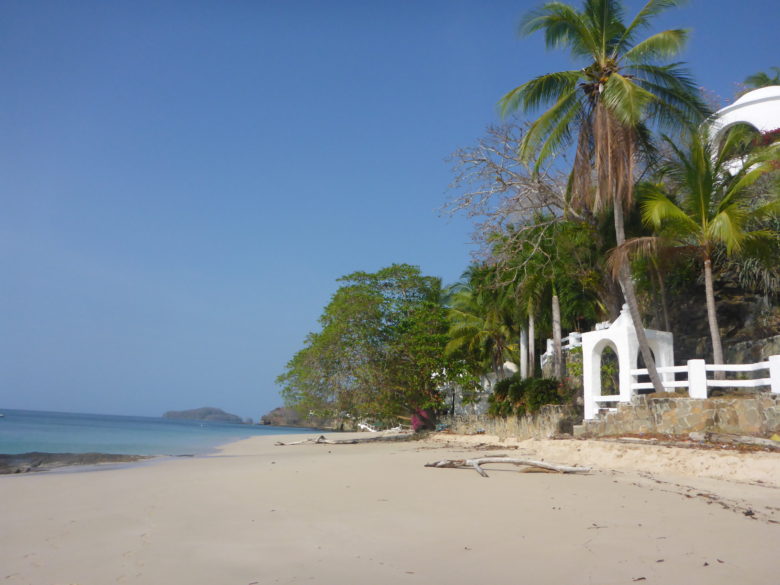Waiting for the Blue
8:37.4N 79:01.8W
V formations of cormorants and pelicans move purposefully across the sky, sometimes there are the two types in the same formation, led by Mr Pelican. We creep from our anchorage at 06.32am leaving behind oily brown water filled with manmade and natural detritus, pass the last anchored ships, Top Rich and Mandarin Grace and head off on 116’ toward the Las Perlas Group of islands. The column graph skyline of Panama fades away and the sea turns a promising shade of green.
The Gulf of Panama is shallow, no more than 50 metres deep, that glorious mid Atlantic blue is not going to happen. So we correct Zoonie’s list to starboard by making water into her port tank from clean green water. 55 litres per hour and the gauge needs to rise from 16” to 21” to have a full tank or just wait till it comes out of the galley sink tap.
“This is your exceptional weekend programming, on Ultra Stereo” the Panama Radio station bleats as the popular music plays on, mostly UK and US music. BBC World Service piggy backs on the same frequency, 98.90 which is partly why we tune in.
Three fishing boats equal distance from one another reveal the lead boat is towing the others, they wave cheerily as we pass; that’s fuel economy for you!
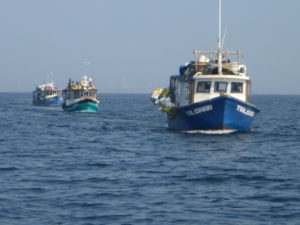
The distant Las Perlas appear faint grey ahead just as a group of False Killer Whales fish enthusiastically around us. They are bigger than dolphins and have black backs. Our book describes them as lively and acrobatic and they certainly are, arching clean out of the water with twists and somersaults. One came close alongside us, about 15’ in length and quite beautiful. Frigate birds join the feeding with artistic dives to pick up any fish tit bits.
Around midday, with our destination in full view, suddenly the fishing line whirrs out of the stern “That’s a bite Barb.” My cue to nip below for the pliers, fish knife and chopping board, just as the galley sink tap starts to overflow. It’s all go sometimes I thought, turning off the water-maker. We’ve caught a Spanish mackerel. Bigger than the type we know in home waters with pretty yellow spots on its sides. “Well that’s supper sorted,” said Rob proudly.
“Look at those birds over the island.” There were hundreds all along the top of the trees and beneath them, on a golden sand beach were three ships. One was a wreck and the other two were busy offloading their cargo of building goods to waiting hands and a pick-up truck.
Nice to be turning the corner to our anchorage with full water tanks, well charged batteries and a charged up computer plus a fresh fish supper to look forward to.
Instead of the anchorage off a sandy beach we found the area full of occupied mooring buoys. Panamanians power to this island at weekends (the day was Saturday) and we were left the deeper waters on the periphery. We anchored in 13.4 metres and knowing the tidal range here is vast, Rob laid 50 of our 80 metres of chain, more than we have ever laid before. The day before the twice yearly HAT (High Astronomic Tide) with a range of 19.9 feet between high and low water. At high water our sounder read 20.1 metres, nearly 6 metres more than when we anchored, that’s over 19 feet.
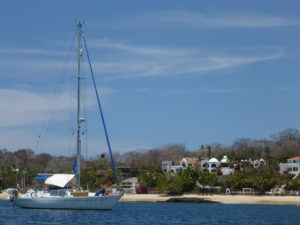
We celebrated our successes with a drop of Curacao Blue and alarmed ourselves the next morning with a blue loo!
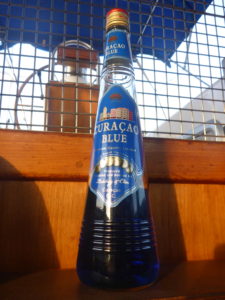
Contadora is a holiday island speckled with luxury homes, second homes and derelict resorts where once Panamanians and American Forces relaxed. There are 694 permanent residents, a school, church and many small businesses supporting the tourist industry.
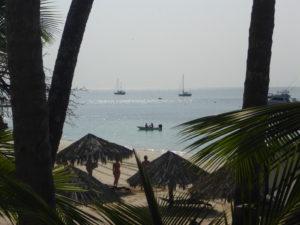
We motored ashore and walked the whole island. Wherever there were hibiscus or bougainvillea tiny green humming birds flitted busily. We walked by the airstrip and through a vast wooden built and rotting holiday complex. Rusty swings, an overgrown football pitch and inside a fine green marble floor covered in dust and leaves and a polystyrene Mayan image on a roof beam in the bar was all that was left to tell the story.
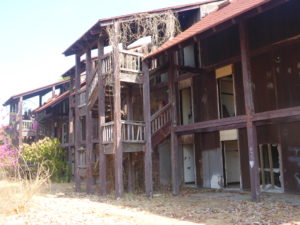
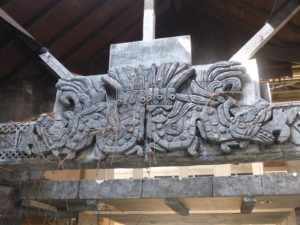
Back in 2000 this wooden beach resort, The Contadora Resort Hotel had just extended its rooms to 470 and hosted meetings for foreign statesmen because it was easy to provide a high level of security on such a small island. However even as the plaster dried the Americans had decided to pull out and the house of cards collapsed.
In the busy port at the end of the runway a ferry was moored offshore, its passengers being ferried ashore in locals’ boats. We sat in a disused bar watching a family of five having their bags checked by ‘customs’ in the form of aero-naval police. Even the little girls pink case was unzipped and Teddy jumped out, sick of his confinement.
All around water features and fountains are dry and swimming pools hold only the water that is left after months of dry weather and evaporation. Trees and plants wither in the lack of this essential resource. The island has a small desalination plant but is it not enough for the modern demands and another has been promised that will cost $13.5 million and produce 150,000 to 200,000 gallons of fresh water every day. It cannot come too soon.
We enjoyed a cool beer at The Beach Club Hotel on Cacique Beach where we were anchored and used their Wi-Fi. It still amazes me that when Wi-Fi works I can download one of my favourite author’s works, to read on my Tablet Kindle App while anchored on an isolated tropical island, when the book was only published two days before.
Then after a cool swim around Zoonie, Shelley and Kyle from a Dufour 45 called Blowin Bubbles, motored alongside us and we asked them aboard for a drink.
It’s only a month now to our Amazon trip! We’ve realised we will not have any shore power or probably shore water from Guadeloupe to New Zealand! Thank goodness for the new batteries, water-maker and solar panels.
Yesterday morning, the 14th March, the shadowy hills of the Colombian coast were quite visible 17 or so miles east of us. We had a lazy morning, a rare event for us, and chose our next anchoring spot between two islands south of us, Isla Chapera and Mogo Mogo, where the tv series Survivor is filmed, I’m not sure if that’s the UK or US version. We went ashore for lunch at Dorio, a charming open air restaurant run efficiently by a team of ladies and had burgers, chips and Coke. We were going to snorkel around the rocks but an American lady came from her swim to ask for white vinegar at the bar because she’d been stung by jellyfish, so we chose Zoonie’s benign company for a swim instead.
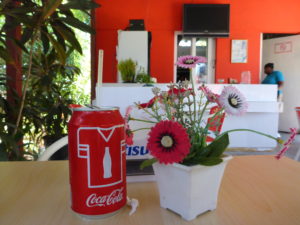
The mooring buoys are now all empty but we chose not to move as we were going to Blowin Bubbles for supper and it would only lengthen the dinghy ride back in the dark.
08:35.2N 79:01.2W. The Channel between Isla Chapera and Mogo Mogo.
We took a slow ride to our next anchorage between Isla Chapera and Mogo Mogo to give time to make water and charge the computer and exhausted anchor windlass battery. It took it 8 minutes to retrieve the 50 metres of chain Rob had put out.
This time it took only 35 metres as our spot was shallower and the range is decreasing now we are moving away from spring tides.
We had lunch and went ashore for a snorkel from the beach. I saw my first live puffer fish, with massive eyes and covered with spines, the one in the photo gave up swimming a long time ago. There was a good variety of the sort we see in son in law Gary’s tank at home. Also pipefish, baby fish and clouds of what may have been krill. All the while tiny jellyfish were pricking us with miniscule stings. In a clear, cold patch of water a beautiful new bed of orange coral was growing near the shore and safe from harmful anchors.
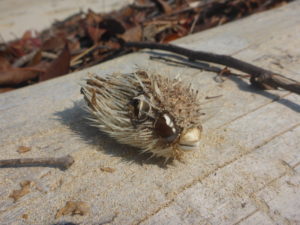
I popped my face above the water and eyeballed a big black heron as it fished the shoreline a few feet away. Above the shoreline and just into the woods were masses of plastic bottles and other human waste. Someone had made a lovely swing from a bamboo cane with green ropes. It was quite wide enough for two. Rubber tyres were hung from trees. This is a paradise for children.
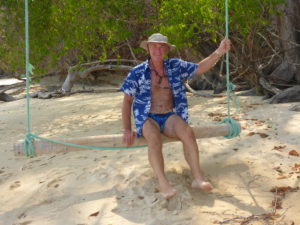
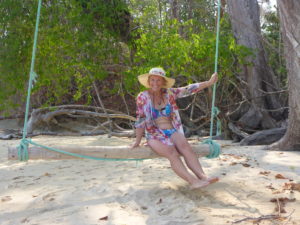
There were lizard tracks in the sand and crab holes surrounded by pea sized balls of sand like mini cannon balls.
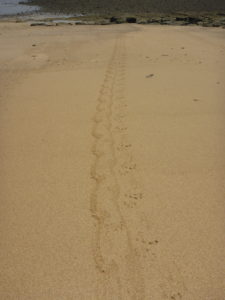
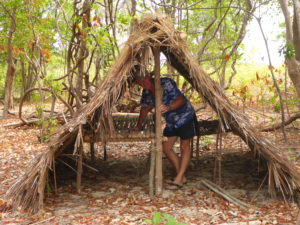
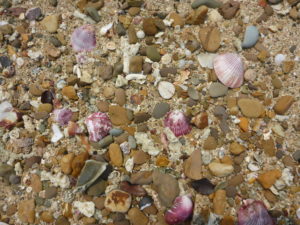
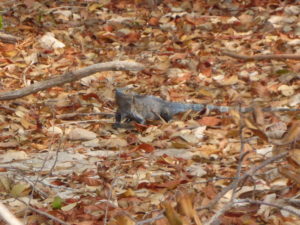
Kyle and Shelley from Blowin Bubbles had invited us and a family from another ketch ashore for sundowners. Published author Andrew and Janet Gunson and their two young lady companions had just returned from the Galapagos and on route nearly ran into a vertical wall of sleeping whales!
This is a truly relaxing place to explore and watch local fishermen catching fish, lobster and oysters to eat and for their pearls. We were just offered some pearls and an enormous fish but we declined thinking it too big. They must have thought we were nuts.
A Nocturnal Intruder.
I awoke in the dark hours knowing we were not alone on board, there was a sense, a presence sharing our space. I got up and checked through the cabins. Back in bed, out of the corner of my eye I saw a dark shape pass across the hatch and decided, erroneously, it was the shadow of the wind charger turning. Then something flew past me and I felt its draft.
“Rob, there’s a bird in here.” I put a light on and the ‘bird’ continued its flight trying to find a way out.
By the time we had scrambled into the saloon he was hanging upside down from the ceiling next to the port side big window. It wasn’t a bird it was a bat! Rob tried to open the window so he could fly out but the bat was frightened and flew into the fore-cabin. Its next stop was the loo floor.
“Pass me a pair of thick gloves babe.” Carefully Rob picked up the lovely creature whose outstretched wings reached about a foot, while I took the top grill out of the companionway so he could be released.
Another missed photo opportunity, sorry.
08:27.50N 78:59.9W. With Wild Berry in Viveros.
17th March 2016. Wild Berry is a baby blue coloured 74 foot Sunreef Catamaran, number one of her type built in Poland. Andrew and Sadie are the English skipper and hostess for the Texan owners. They came alongside in a canopied tender and invited us aboard for supper the following day.
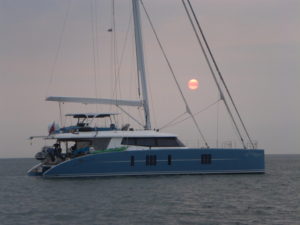
Panic set in, what could we take them? We were out of wine, running short on beer and had no fresh fruit left!
Then along came our saviours in the form of three local fishermen who sold us two fine Spanish mackerel. They wanted $4 for one but then we only had a ten dollar note, so instead of giving us change they gave us another fish!
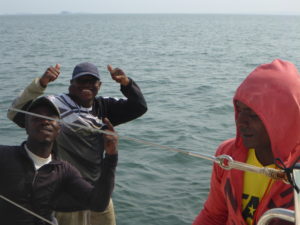
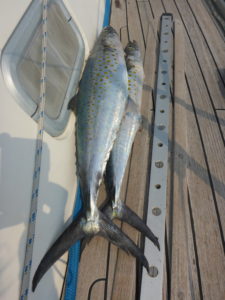
When Sadie and Andrew returned from dropping a friend off in Contadora for the ferry back to Panama we gave them one of the fish. Perfect.
Next morning we went ashore to explore and found a track leading up to the aggregate road at the top of the island. In the growing heat we walked in the direction of the airstrip which shows up on one of Eric Bauhaus’s satellite photos of the island. But what we found was a quarry and more tracks. We also heard a generator running but as it was becoming very hot so we backtracked to the beach.
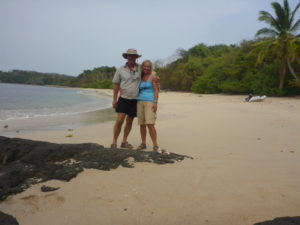
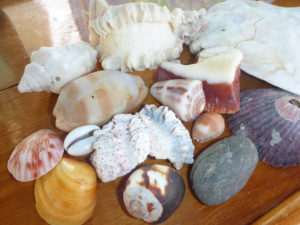
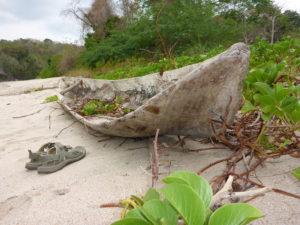
If there is development under way on the island it must be on the north shore.
Back with Zoonie we took cleaning gear into the tender and gave her white topsides a thorough clean after her Panama Canal experience had left oil and rubber residue marks. It was a pleasant bit of exercise, one of us holding the tender in and the other washing, then swapping over for the rinsing.
That job done we went for a well-earned cooling dip swimming around Zoonie a couple of times. I always feel safe if I am swimming alongside her hull, out of sight of 50% of the local predators anyway.
The intense heat of the afternoon called for relaxation in the shady cockpit as we sat in this lovely bay.
At 5.05pm we motored over to Wild Berry and sat at the dining table in the cockpit for drinks and canapes. Then Sadie showed us around below and Andrew took us around the decks.
Sadly there have been numerous problems with Wild Berry being the first of her kind. The mainsail is away for repairs. The damage being caused by the poorly designed rigging layout. The owners and crew have had to put off their Pacific crossing twice because of the problems and hopes for a crossing this season are fading. I feel their frustration.
The easy conversation continued over Sadie’s delicious home-made pizzas and salads. Andrew gave us the co-ordinates of a rock in the anchorage at San Jose Island that is not shown in the Bauhaus Guide. Wild Berry found it the ‘hard’ way on her way in there. Fortunately they are both scuba instructors and were able to fill the dent in the starboard keel with under-water epoxy while she was anchored there.
What seemed like a few minutes later we checked our watches and found it was nearly two o’clock in the morning. We thanked them both for a great evening and motored back to Zoonie in the light of the waxing moon. Maybe we will meet again in Polynesia, I hope so, we’d love to meet Wild Berry’s owners as Sadie and Andrew painted such a glowing picture of them.
08:17.75N 78:54.25W King Toe and the Pile of Pearls. Isla del Rey
19th March 2016. We headed around numerous islets and skirted shallow areas passing close to the southern tip of Isla Del Rey (Island of the king) to the sheltered, sandy bottomed anchorage off Rio Calcique, which means local chief.
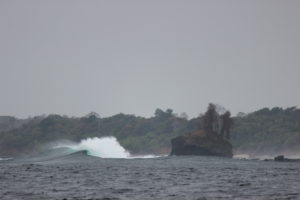
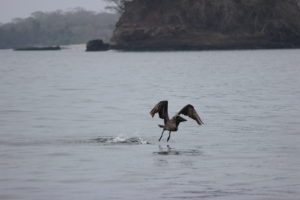
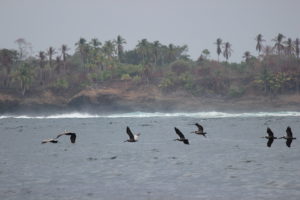
Back in the 16th century King Toe reigned supreme here until the Spanish came along, overturned his rule and in 1551 plundered his entire stash of pearls, tons of the beauties. One was worn by Queen Mary Tudor. They would have shipped them to Panama, transferred them by land across the isthmus to galleons waiting off Colon and as they sailed eastwards through the Caribbean, may well have fallen prey to the French and British privateers, for a little unwelcome re-distribution.
It is always a relief to know the holding is good in an anchorage and very quickly we were taking in our surroundings from the excellent vantage point in the cockpit. A Swiss yacht was anchored near us and the family of four were ashore swimming and, well, being a family on their circumnavigation.
The Rio or river runs inshore from the right hand side of the beach. None of the Bauhaus photos went far enough inland to show us the extent of the river, but we thought we’d explore by inflated canoe the next morning.
We paddled via the Swiss yacht for a chat. They, like us, were waiting to head south out of the Panama Bay, and then they were off to Galapagos with their two blonde-haired girls. The girls had to get back to their school books so we paddled on to the shore to explore the beach before starting up the river a couple of hours before high tide.
Following a track into the jungle, suddenly a dog, rendered thin by the heat, appeared around a corner and then a young boy with a sack over his shoulder. He was followed by his older brother in the same activity and another dog, a female with many litters to her name judging by her under-carriage.
The younger boy started to ply us with Spanish. They had papayas and melons to sell, but we had to sign language we had no money on us. They understood we were from a yacht and as they still had plenty to do would await another opportunity to sell to us later.
They were subsistence farmers and apart from fruit and a few veg grown in a clearing they appeared to be cultivating what looked like caraway seeds for the Chilean market, they were Chilean sacks anyway.
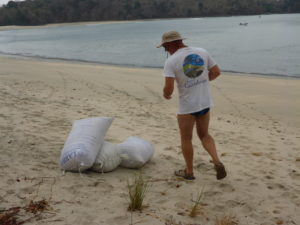
At the river end of the beach rollers were breaking over the sandbanks so we carried the canoe until we were upriver from them and then launched ourselves into the complete unknown, for us. Crocodiles? I wondered as we were carried by the three knot tide upriver.
The water was so clear we saw the many varieties of fish inspecting our black hull. In the trees birdsong, some tuneful, some raucous like a squeaking door, filled the air.
As we went further in the river narrowed, the banks encroached and the canopy of trees closed over us. Mangrove roots sucked goodness from the bubbling mud and white Ibis with curved orange beaks perched on low branches. The sheer beauty of the light playing on the water and foliage reminded me of the English canals.
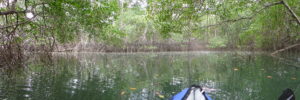
The river meandered in sensuous curves and bends and as we came around one something about a metre and a half long, brown in colour, slithered down a bank and, making a loud splash into the water, disappeared.
“Rob do you think that was a croc?” I asked in subdued tones.
“Could well have been babe.” In silence we both reasoned that if it had scurried out of sight on our approach it was more fearful of us and was not likely to attack. Also if it was an animal that could live on land and in water, was low slung and needed some smooth bank clear of mangrove roots to move, there was little else it could be.
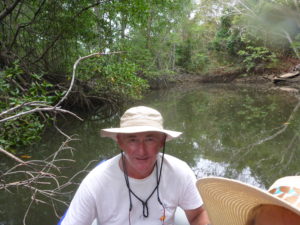
This encounter enhanced the knowledge we were travelling in an area that was virtually untouched by human activity. I wondered where King Toe’s tribe had lived. Maybe like the Mayan Jungle, it has all been reclaimed by nature.
The tide continued to lead us in for another hour before it slowed, the floating leaves slowing down alongside us and we turned to paddle gently back down-river. Tiny silver fish jumped above the water next to us, our mini escort like coins in a fountain. The Croc Bank was by now underwater of course and before we’d even thought about it we were back where the river widened to the estuary.
As the tide was now high and the sandbanks were covered the rollers were much reduced and by keeping close to the shore on the left we paddled a quarter of a mile further out before turning for Zoonie, our delightful home target.
Back aboard with the canoe drying upside-down on the foredeck we took another cooling swim around Zoonie, then just as I was showering off the locals came out to us in their boat, two ladies, dad, the two boys and the two dogs with a dozen of the sacks loaded aboard.
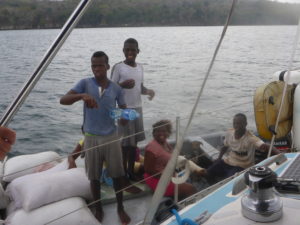
They sold us two melons and two papayas, one of each was ready to eat and the others would be in a few days! How thoughtful I thought, enough fruit for about 8 days. So thanks to the local people we had fish for four days and fruit for a week – who needs supermarkets!
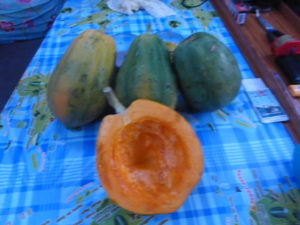
Our planned Rio Cacique expedition now complete we prepared to leave the next day. In the evening we had a candle lit supper in the cockpit and marvelled at how the waxing moon was scattering tiny pieces of gold leaf in the clear water around us.
08:13.25N 79:06.25W San Jose a beau lieu with sharp teeth.
21st March 2016 Batman to the Rescue
I had mixed feelings about anchoring in the SE area of San Jose. As we motored across from Isla Del Rey I remembered Andrew’s rock, now marked on our Bauhaus chartlet. The bottom was rock with sandy patches and no knowing how deep the sand was. Just up the coast was Ensenada Playa Grande, a long beach with good sandy holding, but no Wi-Fi, which was our main reason for visiting.
The Americans had carried out chemical weapons testing on the west side of this island, leaving many cases of leukaemia in the human residents and malformed lizards. Also they had dumped two containers of the deadly stuff in the not very deep water between the two islands. We won’t be making water here.
On the other hand the resort Sadie had described sounded well worth a visit. Made of wood, we could see the resort as we motored in past Smoked Monkey rock and it blended in perfectly with the scenery. There was apparently a lovely infinity pool looking over the bay and a strong Wi-Fi signal we could do with for sending you all some photo files and check on our destination, Puerto Amistad, Ecuador.
We gingerly followed our waypoints in and searched for patches of sand. Down went the anchor but as I reversed Zoonie gently to bury it the anchor appeared to drag.
Rob then dived down to see where the anchor was, in rock or sand. On his return I motored gently ahead to lift the anchor away from the rock. When this didn’t work Rob dived again to attach the tripping line to the anchor but as it was in 6 metres of water it was too far down.
The engine was then in neutral and Rob was trying to retrieve it using the windlass. Suddenly a 20 knot gust of wind came hard at us and pushed Zoonie backwards. Her bow dipped alarmingly and there was a loud graunch. “Windlass has broken off its base Barb.”
Rob returned to the cockpit so we could have a joint ‘think’. Of course he would have to retrieve it by hand. Fortunately just as it happened Rob was able to wrap the snubbing line around a cleat so no more chain could go out.
On went his ‘bat’ gloves, (well ok it was a tenuous link, Batman to the Rescue, but not half as tenuous as the connection between the windlass and its base, as I will tell later.)
This time Zoonie had to creep forward as Rob hauled the chain in. A mistake on my part could cost him fingers. Gradually the chain came home and as soon as Rob felt the anchor weight he knew we were clear and I could backtrack along our safe route into the bay using the IPad with its Raymarine app, while Rob wedged the windlass on top of the chain in the locker with a fender at either side so it couldn’t harm the hull.
“So it’s off the Ecuador two days early then my love!” I wasn’t sorry.
